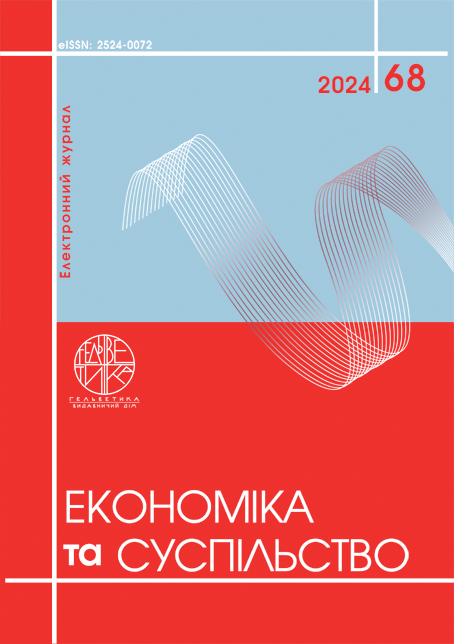ANALYSIS OF THE ACTIVITIES OF ENTERPRISES IN THE ENERGY SECTOR OF THE ECONOMY IN DANGEROUS CONDITIONS
Abstract
Analysis of the activities of energy sector enterprises in dangerous conditions, such as war or economic crisis, is critical for ensuring the stability and development of the national economy. In Ukraine, given the ongoing martial law (military actions), the energy sector faces numerous challenges that require a comprehensive approach (from the initial stages and taking into account the crisis stages) to the analysis and improvement of the entire personnel management system, the enterprise. Analysis of the total number of operating business entities in 2014-2023 showed that the number of enterprises increased in 2023 compared to 2022 by 10,5%. And such reasons as: military actions and occupation of the territory (physical destruction of enterprises and infrastructure, as well as temporary occupation of significant territories of Ukraine), economic crisis (real GDP of Ukraine decreased by 29.1%, which was the largest drop in the country's history. In 2022, gross fixed capital formation decreased by 34.3%), logistical problems (blockage of seaports and disruption of logistics connections led to significant difficulties in supplying goods and raw materials), shortage of energy resources (electricity shortage, failure of enterprises to adapt to dangerous conditions), labor migration (labor shortage, personnel famine), rising unemployment and falling incomes of the population (loss of about a third of jobs in Ukraine, which affected the purchasing power of the population and the general economic climate) together created a difficult economic situation for Ukrainian business in 2022, which led to a significant decrease in the number of enterprises and their activities. Analysis of the energy sector of Ukraine by type of economic activity showed that the number of operating entities increased by 16% in 2023 compared to 2022, despite the impact of risk factors that threaten the functioning of enterprises in this sector. With the exception of enterprises engaged in electricity distribution, their number decreased by three enterprises.
References
Дячук О., Подолець Р., Юхимець Р., Пеккоєв В., Балик О., Сімонсен М. Заключний звіт. Довгострокове енергетичне моделювання та прогнозування в Україні: сценарії для плану дій реалізації Енергетичної стратегії України на період до 2035 року. Київ-Копенгаген. 2019. URL: http://surl.li/vxjcle
Енергетична стратегія України на період до 2035 року (проект) // Безпека та конкурентоспроможність: Біла книга енергетичної політики України / Національний інститут стратегічних досліджень при Президентові України. – К. : НІСД, 2014. – 41 с.
Завербний, А., Кісь, М., & Білоус, Ю. (2023). Проблеми і перспективи залучення зовнішніх інвестицій у проекти відновлювальної енергетики україни у воєнний та післявоєнний періоди. Економіка та суспільство, (51). https://doi.org/10.32782/2524-0072/2023-51-10
Карбовська Л.О., Якушик І.Д., Фещенко О. Л., Каліна І. І., Козлова А. І. Забезпечення сталого розвитку економіки та підвищення енергетичної безпеки на основі використання відновлюваних джерел енергії: проблеми та перспективи. Фінансово-кредитна діяльність: проблеми теорії і практики Том 5 № 36 2021 https://doi.org/10.18371/fcaptp.v2i37.230338
Кобєлєва Т., Перерва П. Методичні засади моніторингу показників енергетичної безпеки в діяльності бізнес-структур. Енергозбереження. Енергетика. Енергоаудит. № 3(181) (2023) с.33-42 DOI: https://doi.org/10.20998/2313-8890.2023.03.04
Кошельок, Г., Пудичева, Г. (2021). Економічна безпека енергетичних підприємств. Економіка та суспільство, (28). https://doi.org/10.32782/2524-0072/2021-28-43
Кузьмін В. М. Формування системи моніторингу рівня енергетичної безпеки регіону. Інфраструктура ринку. 2017. Вип. 5. С.145-148. URL: http://www.market-infr.od.ua/journals/2017/5_2017_ukr/31.pdf
Петровець, С. (2023). Економічний аналіз та перспективи розвитку енергетичного сектору в україні. Вчені записки Університету «КРОК», (4(72), 60–64. https://doi.org/10.31732/2663-2209-2023-72-60-64
Шевцов А.І., Земляний М.Г., Бараннік В.О. та ін. Енергетична безпека України: стратегія та механізми забезпечення / За ред. А.І. Шевцова. – Дніпропетровськ: Пороги, 2002. – 264 с.
Which market is the most attractive for energy transition investment? 2021. Available at: https://2021.global-climatescope.org/
Державна служба статистики України. URL: https://www.ukrstat.gov.ua/
Dyachuk O., Podolets R., Yukhymets R., Pekkoev V., Balyk O., Simonsen M. (2019) Final report. Long-term energy modeling and forecasting in Ukraine: scenarios for the action plan for the implementation of the Energy Strategy of Ukraine for the period until 2035 [Dovhostrokove enerhetychne modeliuvannia ta prohnozuvannia v Ukraini: stsenarii dlia planu dii realizatsii Enerhetychnoi stratehii Ukrainy na period do 2035 roku]. Kyiv-Copenhagen. URL: http://surl.li/vxjcle (in Ukraine)
Energy Strategy of for the period until 2035 (draft). (2014) [Enerhetychna stratehiia Ukrainy na period do 2035 roku (proekt)]. Security and Competitiveness: White Paper on Energy Policy of Ukraine / National Institute for Strategic Studies under the President of Ukraine. – Kyiv: NISD, P.41 (in Ukraine)
Zaverbnyi, A., Kis, M., & Bilous, Yu. (2023). Problems and prospects of attracting foreign investment in renewable energy projects of Ukraine in the war and post-war periods. [Problemy i perspektyvy zaluchennia zovnishnikh investytsii u proekty vidnovliuvalnoi enerhetyky ukrainy u voiennyi ta pisliavoiennyi periody] Economy and Society, (51). https://doi.org/10.32782/2524-0072/2023-51-10 (in Ukraine)
Karbovska L.O., Yakushyk I.D., Feshchenko O. L., Kalina I. I., Kozlova A. I. (2021) Ensuring sustainable economic development and increasing energy security based on the use of renewable energy sources: problems and prospects. [Zabezpechennia staloho rozvytku ekonomiky ta pidvyshchennia enerhetychnoi bezpeky na osnovi vykorystannia vidnovliuvanykh dzherel enerhii: problemy ta perspektyvy] Financial and credit activities: problems of theory and practice Volume 5 No. 36 https://doi.org/10.18371/fcaptp.v2i37.230338 (in Ukraine)
Kobeleva T., Pererva P. (2023) Methodological principles of monitoring energy security indicators in the activities of business structures. [Metodychni zasady monitorynhu pokaznykiv enerhetychnoi bezpeky v diialnosti biznes-struktur] Energy saving. Energy. Energy audit. No. 3(181) pp.33-42 DOI: https://doi.org/10.20998/2313-8890.2023.03.04 (in Ukraine)
Koshelok, G., Pudicheva, G. (2021). Economic security of energy enterprises. [Ekonomichna bezpeka enerhetychnykh pidpryiemstv] Economy and society, (28). https://doi.org/10.32782/2524-0072/2021-28-43 (in Ukraine)
Kuzmin V. M. (2017) Formation of a system for monitoring the level of energy security of the region. [Formuvannia systemy monitorynhu rivnia enerhetychnoi bezpeky rehionu] Market infrastructure. 2017. Issue 5. pp.145-148. URL: http://www.market-infr.od.ua/journals/2017/5_2017_ukr/31.pdf (in Ukraine)
Petrovets, S. (2023). Economic analysis and prospects for the development of the energy sector in Ukraine. [Ekonomichnyi analiz ta perspektyvy rozvytku enerhetychnoho sektoru v ukraini] Scientific notes of the University "KROK", (4(72), pp. 60–64. https://doi.org/10.31732/2663-2209-2023-72-60-64 (in Ukraine)
Shevtsov A.I., Zemlyanyi M.G., Barannik V.O. et al (2002). Energy security of Ukraine: strategy and mechanisms of provision [Enerhetychna bezpeka Ukrainy: stratehiia ta mekhanizmy zabezpechennia]. Dnipropetrovsk: Porogy, P. 264 (in Ukraine)
Which market is the most attractive for energy transition investment? (2021). URL: https://2021.global-climatescope.org/
State Statistics Service of Ukraine. [Derzhavna sluzhba statystyky Ukrainy] URL: https://www.ukrstat.gov.ua/


